
Design your dream garden today!
Get in touch with our expert garden designers for a quote.
Find out more

If you’re embarking on a landscaping project in 2024, consider adding ground cover plants! These remarkable, low-growing shrubs come in a variety of shapes, sizes, and colours, that will undoubtedly redefine your garden into a charming, multi-dimensional landscape.
Beyond the blooming aesthetics presented by ground covers, they also serve practical purposes, such as reducing the growth of weeds, preventing soil erosion, and defining areas within your garden.
In this article, we breakdown what ground covers are, and reveal the top-trending picks (with helpful specifications) for 2024, so you can achieve a stylish garden landscape suited to your preferences and needs. Dive in to discover your next botanical edition!

Transform Your Garden
Dreams into Reality!
What Are Ground Cover Plants?
Ground covers are plants that grow horizontally, forming a dense carpet that can cover large areas.
Unlike other plants, ground covers are low-growing perennials that act as living mulch, which serves many functional benefits, including conserving moisture, restricting weeds, and regulating soil temperature. They come in a range of colours and textures, including flowering and grassy foliage, making them fabulous plants for ornamental landscaping.
Top Ground Cover Plants for 2024
If you want to refresh your garden landscape in the new year, consider redefining your outdoor space with an assortment of lush ground covers. Whether you’re seeking to embellish your garden with blooming florals or enliven it with evergreen spreads, there are many types of ground covers suited to a multitude of preferences and gardening expertise.
To ignite your landscaping project, explore our top ground cover plant picks for 2024:
#1 Zoysia tenuifolia ‘No-Mow Grass’
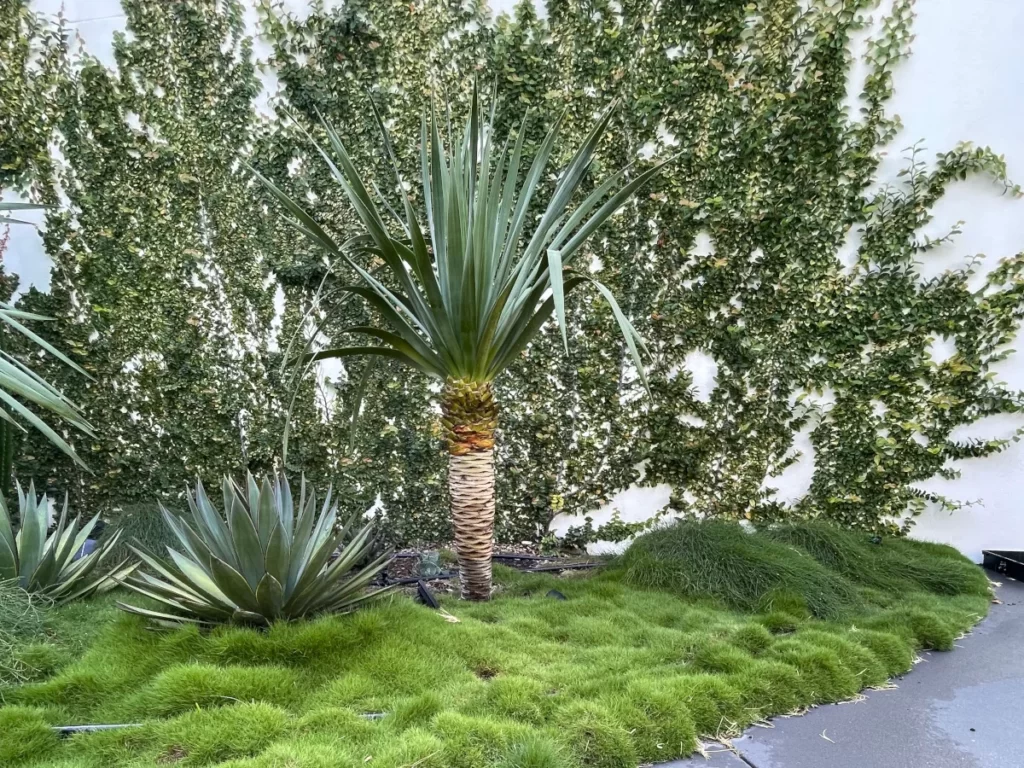
Characterised by a dense mat of endlessly verdant grass, no-mow grass will transform your garden landscape into an elegant oasis. You can decorate your pond or pool area with this ground cover, or plant it in between stepping stones and tiles to achieve separation.
Not only is no-mow grass versatile, it’s also exceptionally low-maintenance, and can thrive in various outdoor settings, including full sun and partial shade.
Plant Profile:
Appearance: A soft and dense carpet of fine-leaf grass
Best For: Beginner and intermediate green thumbs
Native To: South East Asia
Care:
- Can be kept in full sun and part shade
- Requires minimal watering (every 2-3 weeks) – subject to weather
- Needs well-drained soil
- Tolerates cold weather and some frost
- Appreciates a slow-release fertiliser during the spring
Pet Safety: Safe for pets
#2 Rosmarinus officinalis prostrate ‘Creeping Rosemary’
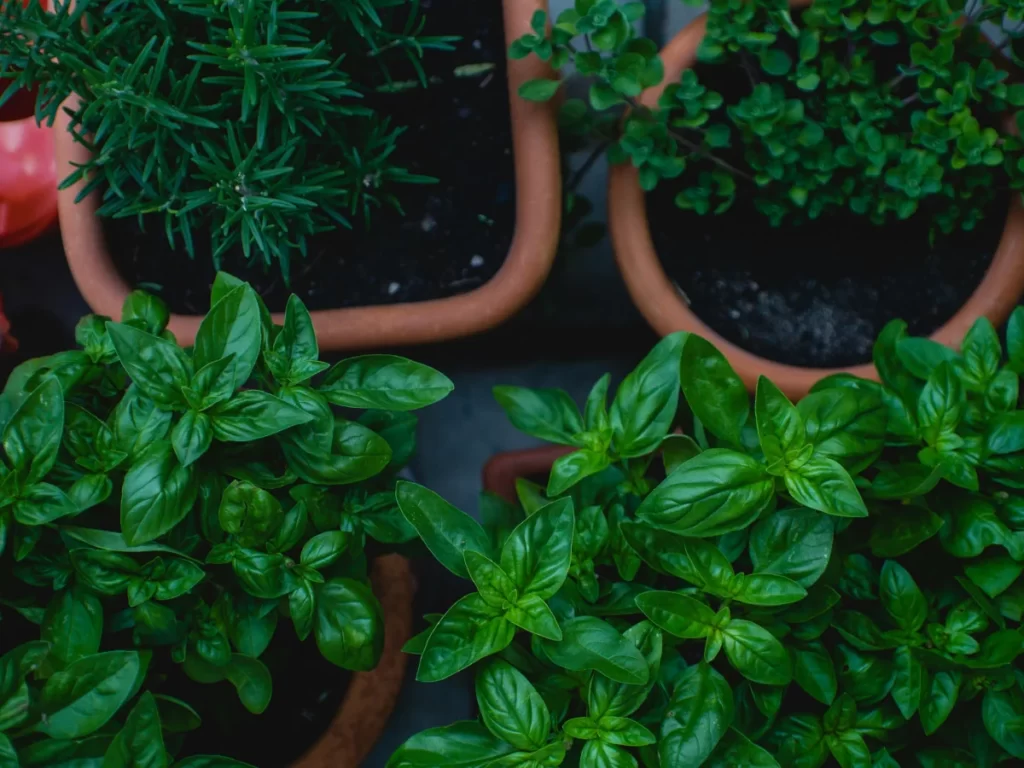
Featuring a cascading spectacle of fragrant foliage, creeping rosemary will take centre stage in your garden landscape. With slender stems that flow over the edges coupled with delicate blue flowers, this aromatic herbaceous plant will infuse your garden with enchanting beauty and delightful scent, creating a multisensory outdoor retreat.
Plant Profile:
Appearance: Dark green needles paired with pale blue flowers
Best For: Intermediate and experienced green thumbs
Native To: Mediterranean
Care:
- Enjoys soaking up full sun but can also tolerate part shade
- Needs to be watered 1-2 times a week – subject to weather
- Drought tolerant
- Regularly check for pests and diseases
- Tolerates cold weather – no colder than -9.4°C (15°F)
- Needs well-drained, slightly alkaline soil
- Appreciates a slow-release shrub and tree fertiliser during the late winter or early spring
Pet Safety: Safe for pets – works as a natural flea repellent!
#3 Casuarina ‘Cousin It’
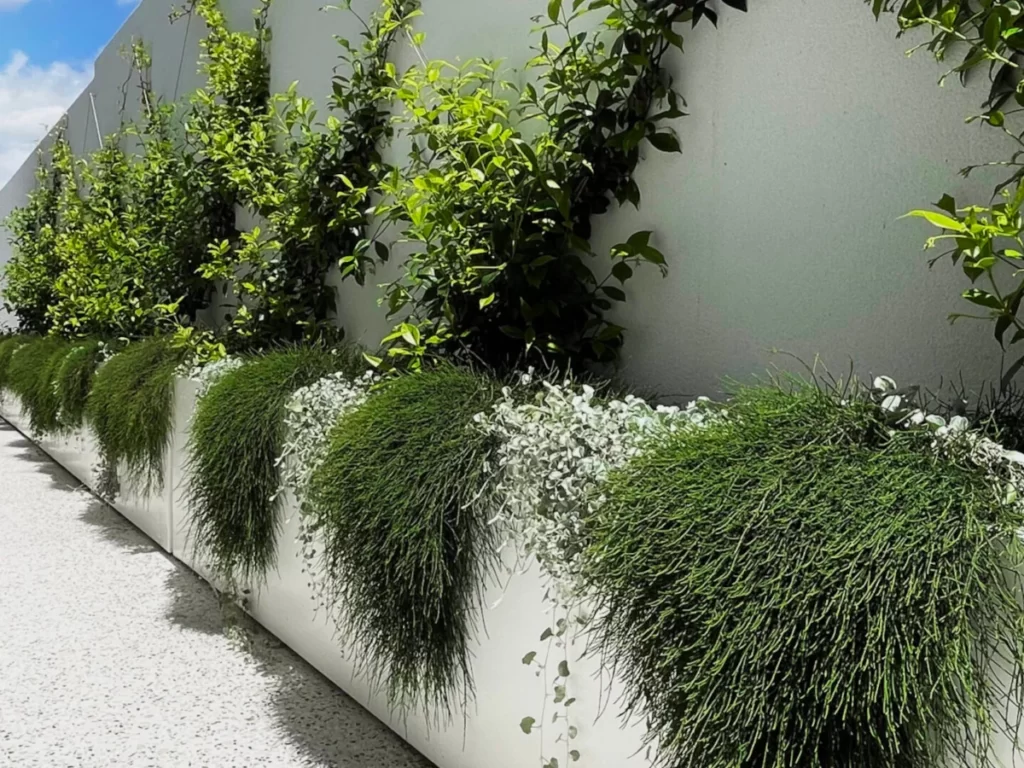
With rich green and endlessly fluffy groundward foliage, Cousin It poses as a whimsical ground cover that will convert your garden-scape into a dreamy fairytale wonderland! Its characterful appearance makes it perfect for creating an eye-catching statement that can beautifully adorn your pathways, borders, and walls.
Beyond its alluring looks, cousin it is renowned for its impeccable resilience and adaptability, making it fantastic for anyone seeking fuss-free plants without compromising on aesthetic charm – it also serves as a natural weed repellent!
Plant Profile:
Appearance: Fluffy and dense green trailing foliage
Best For: Beginner and intermediate green thumbs
Native To: Australia
Care:
- Requires full sun exposure
- Can tolerate poor soil but prefers well-drained and slightly acidic conditions
- Required minimal watering – the soil should be moist but never wet
- Drought hardy and tolerant to light frost
- Use a slow-release fertiliser during spring
Pet Safety: Toxic to pets
#4 Sedum spurium ‘Green Fairy Cushion’
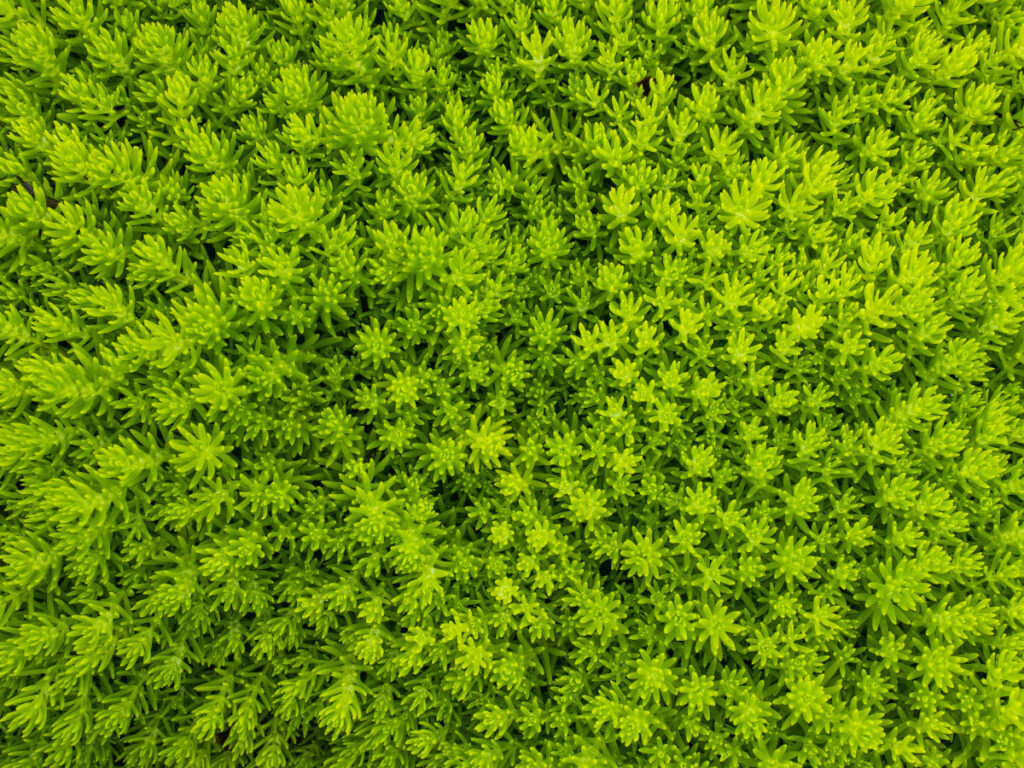
Distinguished by whimsical succulent rosettes that look as if fairies would lay upon them, this unique ornamental foliage serves as an ideal ground cover for those seeking something a little more quirky and enchanting. Aside from the green fairy cushion’s charming appearance, they’re also exceptionally easy to look after, thanks to their drought tolerance!
Plant Profile:
Appearance: Dense foliage of bright green succulent rosettes
Best For: Beginner and intermediate green thumbs
Native To: Asia, Eastern Europe, and the Middle East
Care:
- Enjoys being exposed to full sun
- ‘Soak and dry’ watering method is recommended
- Requires well-drained soil
- Doesn’t typically need fertilising – you may choose to apply a succulent fertiliser during the spring
Pet Safety: Mildly toxic to pets
#5 Dichondra Silver Falls & Repens
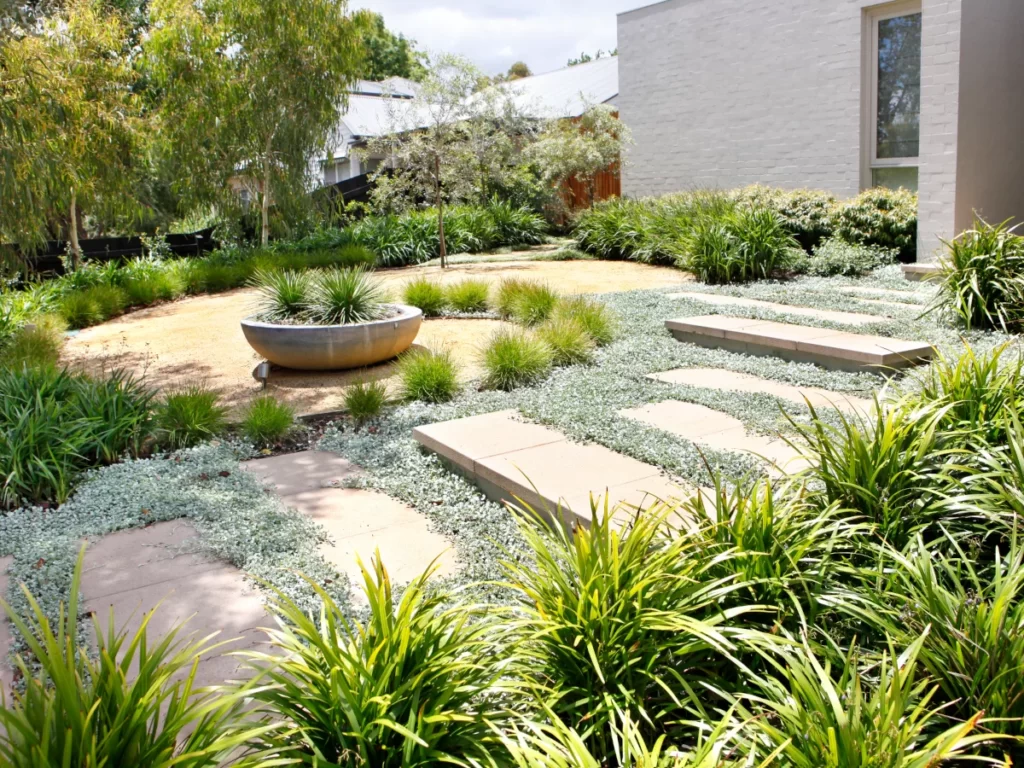
Dichondra silver falls and repens are often applied as an edging plant, providing a trail of elegant texture. Their petite circular leaves collectively form a lush carpet that spills gracefully over borders, nestles between tiles, and frames garden beds.
Beyond their versatile and practical landscaping uses, these border plants are also low maintenance, making them ideal for newbie gardeners, or anyone who wants an easy-going garden!
Plant Profile:
Appearance: Dense clusters of flat circular leaves strung together by low-hanging stems
Best For: Beginner and intermediate green thumbs
Native To: Australia
Care:
- Can handle part shade and full sun
- Doesn’t need pruning or mowing
- Prefers moist soil, so regular watering is recommended
- Appreciates being fertilised twice a year during spring and summer – you can use an all-purpose fertiliser
Pet Safety: Safe for pets
#6 Viola hederacea ‘Native Violet’

Native violet offers a dense bed of rich green kidney-shaped leaves that become embellished with a stunning sea of intricate white and purple flowers during the spring and summer. The dense, graceful foliage of native violet serves as a decadent alternative to a regular lawn that will revamp your garden landscape into a stunning botanical tapestry!
Plant Profile:
Appearance: Dense mat of green kidney-shaped leaves topped with tiny white and purple flowers
Best For: Beginner and intermediate green thumbs
Native To: Australia
Care:
- Enjoys both full sun and part shade
- Appreciates regular watering (about 1 to 2 times a week) during hotter months
- Frost-tolerant and drought-tolerant
- Requires a trim 1 to 2 times a year
- Advisable to apply a mild fertiliser every 2 to 3 weeks during the growing season
Pet Safety: Toxic to pets
#7 Senecio ‘Blue Chalk Sticks’
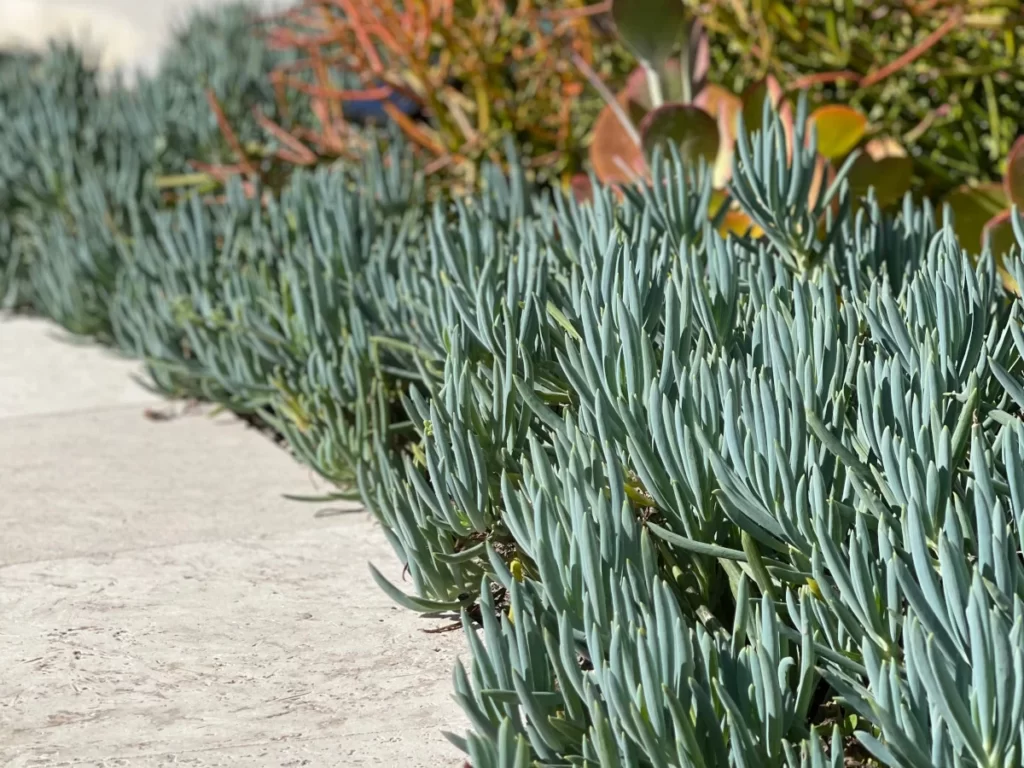
With a dense mat of compact silvery-blue succulents, this evergreen ground cover adds a tasteful coastal flare to garden landscapes. The pale tones that emanate from blue chalk sticks make them an ideal pairing with vibrant foliage plants, creating a striking interplay of contrasting colours.
Beyond their aesthetic charm, blue chalk sticks are immensely practical as they inhibit the growth of pesky weeds, making them an ideal solution for anyone seeking a low-maintenance garden.
Plant Profile:
Appearance: A compact and dense mat of erect silvery/pale-blue stick-shaped succulents
Best For: Beginner and intermediate green thumbs
Native To: South Africa
Care:
- Best kept in full sun
- Drought-tolerant
- Needs free-draining soil
- Only water during the growing months when soil is completely dry
- Don’t require fertiliser, so long as they’re provided with good soil
Pet Safety: Toxic to pets
#8 Scleranthus biflorus ‘Lime Lava’
Lime lava is the perfect ground cover for anyone seeking to create a contemporary garden landscape. Their eye-catching sculptural, mound-like growth pattern and enlivening lime green glow add a modern touch of sophistication and Zen to any outdoor space.
They create a particularly striking contrast when coupled with grey stones and colourful foliage, providing a visual symphony of organic textures and hues.In addition to lime lava’s astonishing beauty, it’s also a remarkably resilient plant, and can withstand frost, as well as coastal and alpine climates.
Plant Profile:
Appearance: Compact lime green mossy foliage in mound-like formations
Best For: Intermediate and experienced green thumbs
Native To: Australia
Care:
- Tolerates full sun and part shade
- Needs to be kept damp, so routine watering is recommended – subject to weather
- Needs well-drained soil to prevent root rot and drowning
- Frost tolerant and can survive coastal and alpine climates
- Appreciates a slow-release native plant fertiliser during spring
Pet Safety: Toxic to pets
#9 Pratia ‘White Star Creeper’
Featuring dainty white star-shaped flowers on a bed of dense green foliage, white star creeper makes a magical garden edition!
This trailing variety of pratia spreads slowly but surely, creating an enchanting string of subtle florals that gracefully weave through your garden landscape. Despite its delicate appearance, they can surprisingly withstand light foot traffic, making them perfect for pathway planting – they’re also great for border planting.
Plant Profile:
Appearance: Small white star-shaped flowers on top of dense dark green foliage
Best For: Beginner and intermediate green thumbs
Native To: Australia and New Zealand
Care:
- Can tolerate full sun but prefers part shade
- Drought-tolerant
- Prefers moist soil – requires regular watering during hotter months
- Appreciates an all-purpose fertiliser during the growing season
Pet Safety: Toxic to pets
#10 Trachelospermum ‘Chinese Star Jasmine’ (Tricolour)
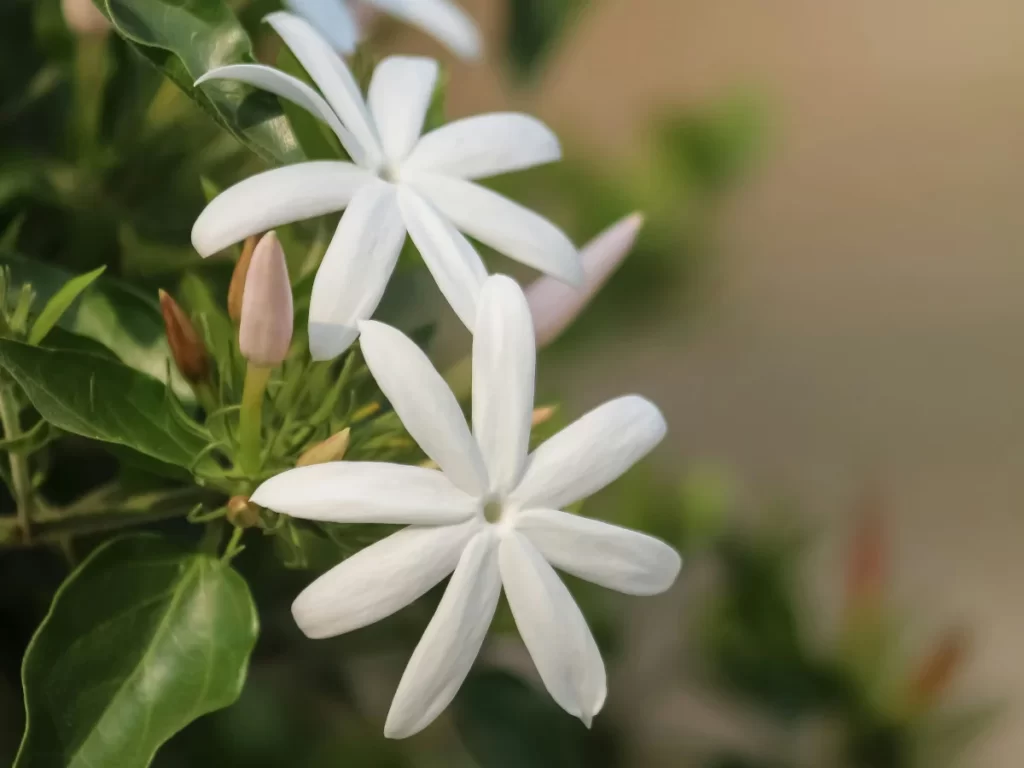
Tricolour Chinese star jasmine is characterised by large and glossy speckled green leaves and delicate pink and white star-shaped flowers. Not only is this plant a joy to admire, but it’s also pleasant to smell! It emits a sweet, fragrant scent that is advocated for its mood-boosting aromatherapy, making Chinese star jasmine both beautiful and beneficial.
This charming ground cover is exceptionally versatile in style and can be planted to achieve a wonderful range of aesthetics, including an idyllic countryside cottage landscape, an enchanting fairytale garden, or even a refreshing coastal oasis!
Plant Profile:
Appearance: Glossy green leaves with white speckles adorned with star-shaped pink and white flowers
Best For: Beginner and intermediate green thumbs
Native To: East Asia
Care:
- Tolerates both full sun and part shade
- Requires a regular watering routine (around once a week) – subject to weather
- Needs well-drained soil
- Drought-tolerant
- Maintain vibrancy and growth by fertilising every six weeks during spring using a well-balanced fertiliser
Pet Safety: Safe for pets
FAQs:
For your convenience, we have answered the most frequently asked questions about ground cover plants below:
Varieties of Dichondra, such as silver falls, and Thymus serpyllum ‘creeping thyme’ are two of the best ground cover plants for preventing the growth of weeds. This is because they form a dense mat that effectively shade bare soil and suppress weeds from growing.
You can actually plant ground cover plants any time of the year, but the optimum time to plant is between late summer and autumn. If you have planted flowering plant ground cover plants, you can expect to see blooming flowers from late spring through to early summer.
There are many varieties of ground cover plants that make popular garden editions. However, the most favoured varieties fall into these categories: vines (such as Dichondra silver falls and Repens), shrubs (like Casuarina ‘cousin it’), and herbaceous (including Senecio ‘blue chalk sticks’).



